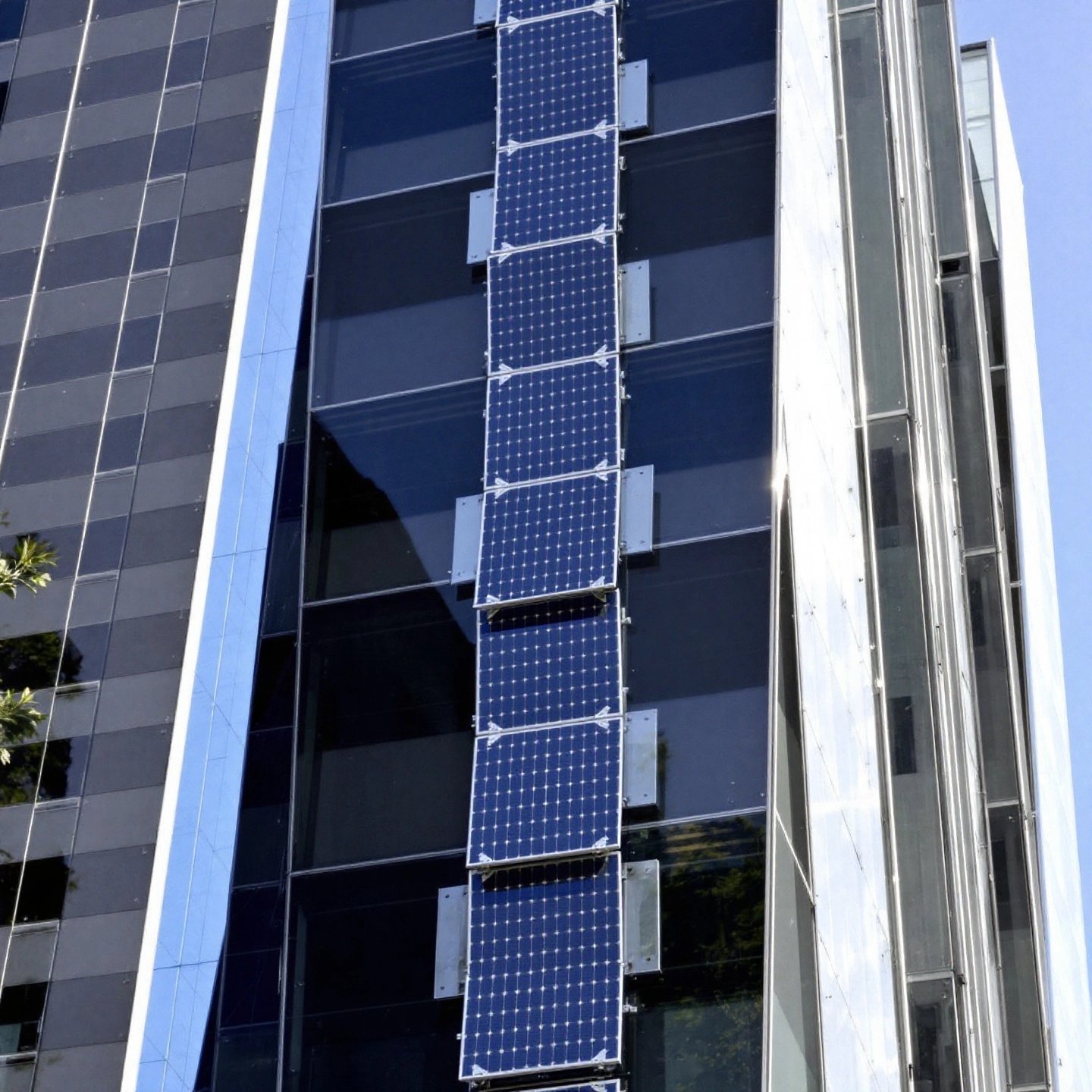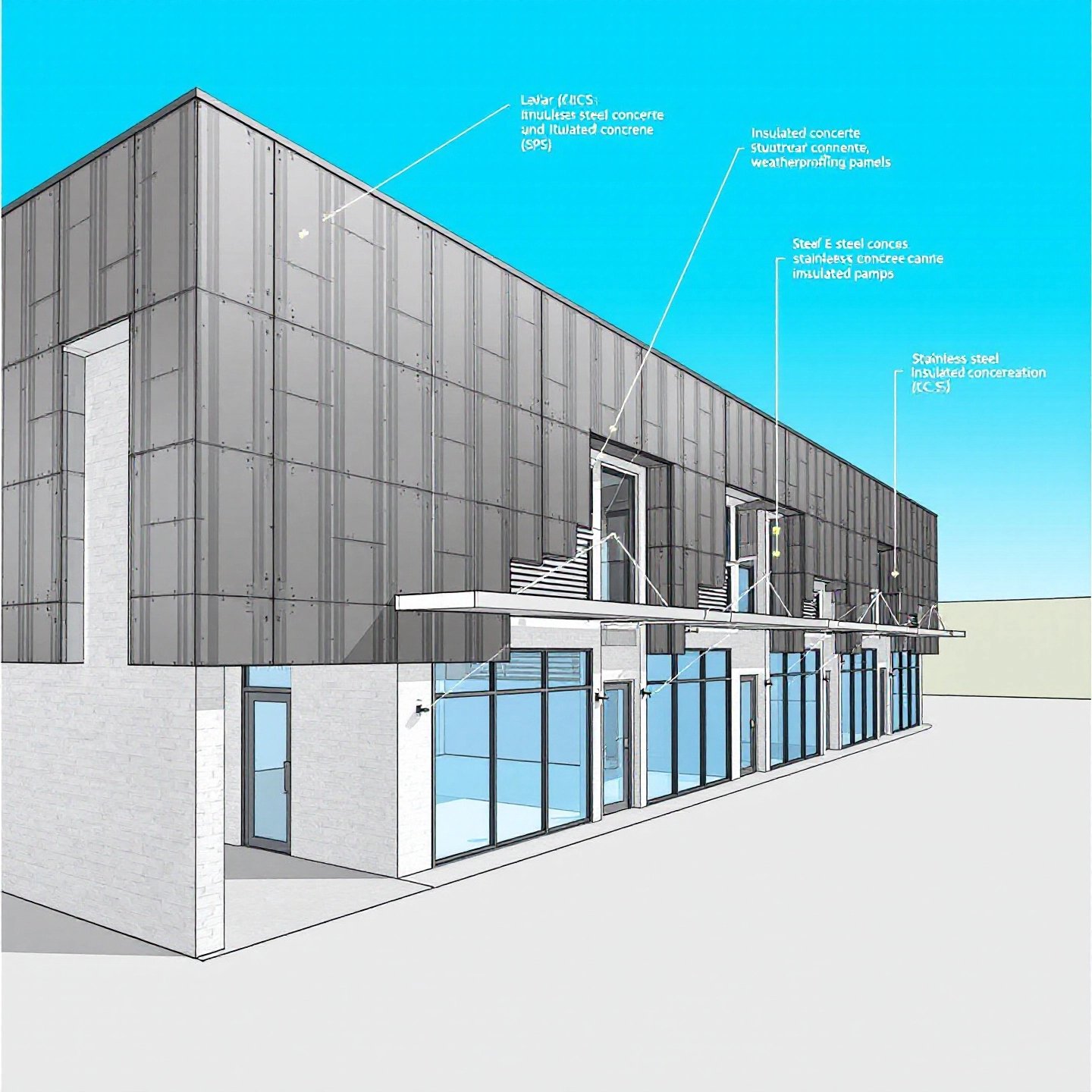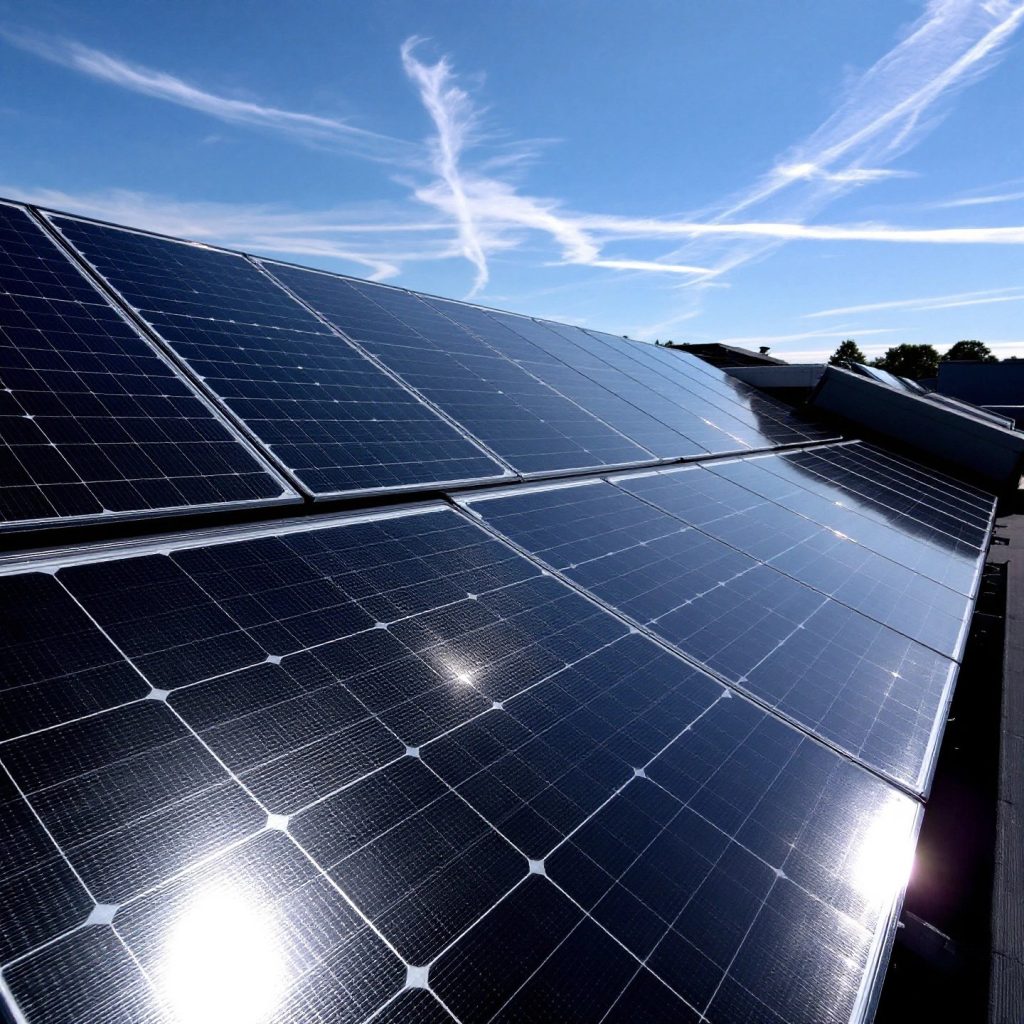Introduction to Solar Panel Wall
Imagine a world where buildings are not just structures but active contributors to energy generation. This is the promise of solar panel walls, an innovative solution transforming modern architecture. As concerns about sustainability and energy efficiency escalate, solar panel walls are becoming a cornerstone in both new construction and retrofitting projects. They offer a dual benefit: reducing carbon footprints while enhancing the aesthetic appeal of buildings.
Solar panel walls integrate into the vertical surfaces of a building, unlike traditional rooftop solar panels. This integration not only maximizes energy production by utilizing otherwise unused facade space but also allows for creative architectural designs. The versatility of solar panel walls means they can be adapted to various architectural styles, making them an attractive choice for both residential and commercial properties.
In this article, we delve into the comprehensive benefits and applications of solar panel walls. Whether you’re considering a sleek, modern look for your home or aiming to meet stringent sustainability standards in commercial buildings, solar panel walls offer a viable solution. We’ll guide you through optimizing their use across different settings, ensuring that your building remains functional, efficient, and stylish.
As we explore this topic, you’ll discover how solar panel walls can transform energy consumption patterns, contribute to eco-friendly living, and align with global sustainability goals. From installation techniques to maintenance tips, this guide aims to equip you with the knowledge needed to make informed decisions about integrating solar panel walls into your projects.

Understanding the Basics of Solar Panel Walls
When you think of solar panels, you might picture them perched atop rooftops, angled to soak up the sun’s rays. But what if the very walls of a building could serve the same purpose? Enter the solar panel wall, a transformative approach that leverages photovoltaic technology to convert vertical surfaces into energy-generating assets.
What Makes Solar Panel Walls Different?
Solar panel walls are a form of Building Integrated Photovoltaics (BIPV), seamlessly incorporating solar cells into the building’s structure. Unlike rooftop panels, which are typically installed at an angle to maximize sun exposure, solar panel walls are mounted vertically. This configuration can be particularly beneficial in urban environments where rooftop space is limited or obstructed by HVAC systems and other equipment. By utilizing the vertical expanse of a building, solar panel walls offer a creative solution to space constraints, turning facades into powerhouses of renewable energy.
The Science Behind Photovoltaic Technology
At the heart of solar panel walls lies photovoltaic (PV) technology. Semiconductor materials like silicon compose PV cells, which transform sunlight into electricity. When sunlight hits these cells, it excites electrons, creating an electric current. These cells are assembled into modules or panels, which can be linked together to form larger arrays, supplying power to homes, businesses, and even feeding into the grid.
Orientation and tilt are crucial factors influencing the efficiency of solar panels. While rooftop panels often benefit from optimal angling, solar panel walls must contend with being vertical. This orientation can result in less direct sunlight capture during midday but can be advantageous during morning and evening hours when the sun is lower in the sky.
Key Terms to Know
- Photovoltaic (PV) Cell: The basic unit of a solar panel that converts sunlight into electricity.
- Module: A group of PV cells assembled together.
- Array: A collection of modules connected to generate electricity.
- Building Integrated Photovoltaics (BIPV): The integration of PV technology into building materials.
Understanding these concepts is vital as you consider incorporating solar panel walls into your building projects. They not only represent a step forward in sustainable design but also offer a practical solution to the energy challenges faced by urban environments. As we continue our exploration, you’ll see how solar panel walls can adapt to various needs, promising both environmental and economic benefits.
Exploring Residential Mounting Methods
When you think about home solar panel installation, rooftop systems often come to mind. However, wall-mounted solar panels are gaining popularity as a viable alternative, especially for homes with limited roof space or structural challenges. Imagine having a home that stands out for its design and contributes actively to energy generation. It sounds intriguing, doesn’t it?
Why Choose Wall-Mounted Solar Panels?
Wall-mounted solar panels offer several advantages. They are ideal for homes where the roof is not suitable for solar panels due to shading, orientation, or structural issues. By utilizing vertical wall space, homeowners can still benefit from solar energy without compromising on efficiency. According to The Eco Experts, wall-mounted panels work best on south-facing walls, ensuring maximum sunlight exposure throughout the day.
Installation Techniques and Considerations
Installing solar panels on walls involves specific methods to ensure stability and efficiency. Here are some key considerations:
- Mounting Brackets: These are essential for securely attaching panels to the wall. Made from durable materials like aluminum or stainless steel, brackets are designed to withstand various weather conditions.
- Load-Bearing Capacity: Before installation, it’s crucial to evaluate the wall’s ability to support the weight of the panels. Consulting with a structural engineer can help determine if additional reinforcements are needed.
- Panel Orientation: To optimize energy capture, panels should be tilted at an angle, ideally between 20 to 50 degrees. These angles can be challenging with wall-mounted systems, but tilting them closer to 60 degrees can enhance performance during winter months.
Interior Setups for Smaller Projects
For those looking to start small, interior solar panel setups can be an excellent option. These are particularly useful in urban settings where exterior space is limited. Interior panels can power specific appliances or serve as a backup energy source, offering flexibility and ease of maintenance.
For homeowners interested in exploring these innovative solutions, Renewable Energy Nexus provides a range of products and expert advice on selecting suitable wall-mounting solutions. Their offerings include various panel sizes and complete installation kits, ensuring a seamless transition to solar energy.
As we move forward, the versatility and adaptability of wall-mounted solar panels will continue to play a crucial role in sustainable home design. Next, we’ll delve into the considerations for commercial installations, where scale and efficiency take center stage.

Evaluating Commercial Installations for Maximum Efficiency
When considering a commercial solar panel installation, businesses and facility managers must navigate a range of factors to maximize efficiency and return on investment. Unlike residential setups, commercial installations often involve larger, more complex systems that require careful planning and execution. Let’s explore the key elements that contribute to a successful solar panel wall installation in commercial settings.
Structural Reinforcement and Weatherproofing
Commercial solar panel walls must withstand various environmental stresses, from strong winds to heavy snowfall. Ensuring structural integrity is paramount. This involves reinforcing building walls to support the added weight of solar panels and the mounting systems. According to Solar Reviews, proper weatherproofing is also crucial to protect both the panels and the building facade from moisture intrusion and temperature fluctuations. Such precautions might include sealing panel edges and using corrosion-resistant mounting hardware.
Compliance with Local Regulations
Compliance with local building codes and regulations is another critical aspect of commercial solar panel installations. These regulations ensure the safety and functionality of the solar systems. For instance, the International Building Code (IBC) and National Electrical Code (NEC) provide guidelines on the structural and electrical standards required for solar installations. As noted by Solgen Power, obtaining the necessary permits and undergoing inspections are essential steps to ensure compliance and avoid potential legal issues.
Optimizing Solar Panel Wall Efficiency
Efficiency is a key concern in commercial solar panel installations. To maximize solar panel wall efficiency, it’s important to consider the orientation and tilt of the panels. While vertical installations may not capture as much midday sunlight as angled rooftop panels, they can be optimized for morning and evening sun exposure. Additionally, using advanced technologies like sun-tracking systems can enhance energy capture by adjusting the panels’ position throughout the day.
Incorporating energy storage solutions, such as solar batteries, can further enhance efficiency by storing excess energy for use during peak demand times or when sunlight is limited. This approach improves energy reliability and increases the overall return on investment by reducing reliance on grid electricity.
As businesses strive to reduce their carbon footprint and energy costs, commercial solar panel wall installations present a viable and sustainable solution. By focusing on structural integrity, regulatory compliance, and optimizing efficiency, companies can harness the full potential of solar energy. Next, we’ll compare solar panel walls with traditional building materials to highlight their long-term benefits and sustainability.
Comparing Solar Panel Walls to Traditional Materials
When you consider upgrading your building’s facade, the choice between solar panel walls and traditional materials like solid surface wall panels or solid wood wall paneling might seem daunting. Let’s break it down by examining the benefits and potential drawbacks of each option.
Solar Panel Walls: A Modern Marvel
Solar panel walls, as innovative building materials, offer unique advantages. Unlike traditional materials, they actively contribute to energy generation, transforming sunlight into electricity through photovoltaic technology. This capability reduces energy bills and supports environmental sustainability by lowering carbon emissions.
In terms of lifecycle costs, solar panel walls often prove more economical in the long run. While the initial investment might be higher compared to standard materials, the continuous energy savings and potential government incentives can offset these costs significantly. Furthermore, as noted by KPI Green Energy, the declining cost of solar technology continues to enhance its affordability.
Traditional Materials: Tried and True
Traditional materials such as solid wood and solid surface panels have been staples in construction for their durability and aesthetic flexibility. They provide excellent insulation and can be customized to fit various architectural styles. However, these materials do not offer the same energy benefits as solar panels.
Moreover, traditional construction materials often involve higher environmental costs. The production and disposal processes can contribute to pollution and resource depletion, as highlighted in the Panel Hub discussions on eco-friendly building solutions.
Long-Term Benefits: Solar Panels Lead the Way
In the debate of solar panels vs. traditional materials, sustainability and energy efficiency are key differentiators. Solar panel walls contribute to a building’s energy independence, reducing reliance on fossil fuels and promoting a cleaner environment. Additionally, they align with global sustainability goals, making them a forward-thinking choice for eco-conscious builders and homeowners.
Imagine a building facade that not only enhances curb appeal but also generates clean energy. By choosing solar panel walls, you invest in a solution that pays dividends both environmentally and economically. As we move forward, consider how integrating smart outlets and accessories can further optimize the functionality of these walls, enhancing both energy management and user convenience.
Integrating Smart Outlets and Accessories
Imagine a solar panel wall that generates electricity and integrates seamlessly with your home’s power system, providing convenient outlets for immediate use. The result is the future of solar energy, where smart solar accessories transform how we harness and manage power.
Solar Panel Wall Outlets: A Game Changer
Solar panel wall outlets are designed to make energy access straightforward and efficient. By integrating outlets directly into the solar panel system, homeowners can plug appliances directly into the solar-generated power source, reducing reliance on the grid. These outlets are typically installed with a micro-inverter that converts the DC power generated by the panels into usable AC power, which can be fed into your home’s electrical system or used directly at the outlet.
For example, a 600-watt micro-inverter setup, as detailed by Plugged Solar, allows for easy connection to a standard wall socket, making it a practical solution for residential installations. This setup simplifies the installation process and enhances the usability of the solar panel wall, providing direct power access where it’s needed most.
Smart Solar Accessories: Optimizing Performance
Smart solar accessories further enhance the functionality of solar panel walls. These include devices like Wi-Fi power monitors, which allow homeowners to track energy generation and consumption in real-time. Such tools are invaluable for maximizing efficiency and identifying areas for improvement. Additionally, using adjustable mounts, like the Ring Solar Panel, can optimize the angle of solar panels, ensuring they capture the maximum amount of sunlight throughout the day.
Accessories such as these not only boost the performance of solar panel walls but also contribute to a more comprehensive energy management system. By integrating these smart technologies, you can better monitor and control your energy usage, leading to greater energy savings and sustainability.
Installation and Accessibility
Installing solar panel wall outlets and accessories is typically straightforward, often requiring no advanced wiring skills. Many systems are designed for easy installation, with plug-and-play components that can be set up in a matter of hours. For instance, the Plugged Solar system allows for a DIY installation with minimal tools, making solar energy accessible to a broader audience.
As we advance in this solar panel wall revolution, integrating smart outlets and accessories will play a crucial role in optimizing energy use and enhancing the overall user experience. These innovations not only make solar energy more accessible but also more practical, paving the way for a sustainable future. In the next section, we’ll explore how to balance the aesthetics of solar panel walls with their functional benefits, ensuring they complement any architectural style.

Balancing Aesthetics and Function in Wall Solutions
Imagine walking down a street where every building contributes to a clean energy future and captivates with its aesthetic appeal. The result is the potential of aesthetic solar panel walls, which blend seamlessly with architectural styles to enhance both function and beauty. But how do you achieve this balance?
Architectural Solar Integration: A Symphony of Design
The integration of solar panels into building architecture is no longer a choice between form and function. Modern designs allow for a harmonious blend where solar panels become an integral part of the building’s aesthetic. Architects are increasingly using building-integrated photovoltaics (BIPV) to merge solar technology with design, transforming facades into energy-generating canvases. According to Solex, these innovations turn structures into living sculptures, where the play of light and shadow creates dynamic visual effects.
Camouflaging and Accentuating Panels
For residential properties that prioritize curb appeal, there are several strategies to either camouflage or accentuate solar panels:
- Color Matching: Panels can be designed to match the color of the building facade, making them less noticeable.
- Frameless Designs: Using frameless solar panels can create a sleek, modern look that integrates smoothly with glass and metal surfaces.
- Artistic Installations: Some designers opt to make panels a focal point, arranging them in patterns or using them as part of a larger artistic installation.
These approaches ensure that solar panels do not detract from the building’s visual appeal but rather enhance it.
Residential Integration Tips
For homeowners, blending solar panels with existing architectural styles involves careful planning:
- Consult Designers: Work with architects or designers who specialize in solar integration to ensure that the panels complement your home’s style.
- Consider Roof and Wall Combinations: Using both roof- and wall-mounted panels can distribute visual impact and maximize energy production.
- Use of Vegetation: Strategically placed greenery can soften the appearance of solar installations, creating a natural, cohesive look.
By focusing on these elements, homeowners can achieve a balance between energy efficiency and aesthetic appeal.
As we continue to explore the potential of solar panel walls, it’s clear that their integration into architectural designs enhances functionality and contributes to the aesthetic value of our built environment. In the next section, we will delve into the maintenance and troubleshooting aspects of solar panel walls to ensure their long-term performance and reliability.
Maintaining and Troubleshooting for Long-Term Performance
Imagine investing in a solar panel wall that not only powers your home but also requires minimal upkeep. It seems like the perfect solution, doesn’t it? While solar panels are known for their low maintenance, ensuring their optimal performance involves a few key steps. Let’s delve into the essentials of solar panel maintenance and how to troubleshoot common issues effectively.
Routine Cleaning and Inspection
Routine cleaning is crucial for maintaining the efficiency of solar panel walls. Over time, dirt, dust, and debris can accumulate on the panels, reducing their ability to capture sunlight. CNET recommends cleaning your solar panels at least twice a year. The procedure can be as simple as rinsing them with water to remove any buildup. In regions with heavy snowfall or dust storms, more frequent cleaning might be necessary.
Regular inspections are equally important. Scheduling an annual check-up with a solar specialist can help identify potential issues before they escalate. During these inspections, professionals can assess for any physical damages or electrical faults and ensure all components are functioning correctly.
Common Issues and Troubleshooting
Even with regular maintenance, issues like partial shading or misalignment can arise, impacting the performance of your solar panel wall. Partial shading occurs when objects like trees or buildings cast shadows on the panels, significantly reducing their efficiency. To mitigate this, ensure that the area around your panels is clear of obstructions.
Misalignment is another common problem. Solar panels need to be correctly oriented to maximize sunlight exposure. If you notice a drop in energy production, it might be worthwhile to check if the panels have shifted out of their optimal position.
For more complex issues, such as inverter malfunctions or electrical faults, consulting a professional is advisable. Sistine Solar suggests that independent troubleshooting is possible, but experts should handle significant repairs to ensure safety and efficacy.
Performance Diagnostics
Modern solar systems often come equipped with monitoring apps that provide real-time data on energy production. These tools can alert you to any unusual dips in performance, allowing for prompt intervention. By monitoring these diagnostics, you can guarantee that your solar panel wall maintains its optimal efficiency.
Maintaining your solar panel wall prolongs its lifespan and maximizes your return on investment. By adhering to regular cleaning and inspection schedules and addressing issues promptly, you can enjoy the full benefits of your solar installation. As we look forward to future innovations in solar technology, these maintenance practices will remain a cornerstone of efficient energy management.

Planning for Future Upgrades and Innovations
Imagine a future where your solar panel wall not only meets your current energy needs but also adapts to evolving technologies and increased demands. Sounds futuristic? This is the promise of future solar panel technology, where scalability and innovation play pivotal roles in maximizing energy efficiency and sustainability.
Scalability and Storage Integration
As your energy needs grow, the ability to scale your solar panel system becomes crucial. Modern systems are designed with expansion in mind, allowing for the addition of more panels without extensive reconfiguration. This adaptability ensures that your solar investment remains viable as your energy consumption patterns change. For instance, integrating battery storage solutions can significantly enhance your system’s efficiency. These systems store excess energy generated during peak sunlight hours, providing power during nighttime or cloudy daysand thus maximizing your solar panel upgrades.
Emerging Technologies: Bifacial and Transparent PV Panels
Emerging technologies like bifacial and transparent photovoltaic (PV) panels represent the next frontier in solar energy. Bifacial panels capture sunlight on both sides, increasing energy yield by utilizing reflected light from surfaces such as the ground or nearby structures. According to GreenLancer, these panels are particularly effective in environments with high albedo, such as snowy or water-rich areas.
Transparent solar panels offer a unique solution by transforming windows and building facades into energy-generating surfaces without obstructing views or light. This innovation enhances the aesthetic appeal of buildings and contributes to their energy efficiency, making them ideal for urban environments where space is limited.
Planning for Future Expansions
To effectively plan for future expansions, consider consulting experts like Renewable Energy Nexus, who specialize in the latest solar technologies and offer guidance on selecting advanced panel types. They provide insights into the best practices for integrating new technologies and expanding your current system to accommodate future needs.
By embracing these innovations, you enhance your energy independence and contribute to a more sustainable future. As we continue to explore the potential of solar panel walls, the integration of advanced technologies will play a crucial role in shaping the energy landscape. In the concluding chapter, we will summarize the benefits of solar panel walls and inspire actionable steps toward adopting these sustainable energy solutions.
Conclusion
Imagine a world where every building not only stands as a testament to architectural brilliance but also actively contributes to a sustainable future. This is the transformative promise of solar panel walls. As we’ve explored throughout this guide, the benefits of integrating solar panel walls into residential and commercial spaces are profound and multifaceted.
Firstly, we cannot overstate the versatility of solar panel walls. They maximize energy production by utilizing vertical spaces that would otherwise remain untapped. This innovative approach enables increased energy independence and efficiency, particularly in urban environments where space is limited. By harnessing the power of the sun, these walls reduce electricity bills and significantly decrease carbon footprints, aligning with global sustainability goals.
Moreover, emerging technologies like bifacial and transparent PV panels enhance the efficiency of solar panel walls. These advancements promise higher energy yields and aesthetically pleasing designs, making them an attractive option for modern architecture. The integration of smart outlets and accessories further optimizes energy management, ensuring that solar energy is not just a source of power but a comprehensive solution for energy needs.
Environmentally, the impact of adopting solar panel walls is substantial. By reducing reliance on fossil fuels, these systems help mitigate greenhouse gas emissions, contributing to a cleaner, healthier planet. They embody the essence of sustainable energy solutions, offering a viable path toward a greener future.
As we conclude, it’s essential to take actionable steps toward embracing these innovative solutions. Whether you’re considering installing solar panel walls in your home or upgrading a commercial space, the benefits extend beyond energy savings. They represent a commitment to sustainability, a step toward energy independence, and a contribution to environmental preservation.
To explore these possibilities further, consider consulting experts like Renewable Energy Nexus. Their expertise in solar technologies can guide you in selecting the best solutions tailored to your needs, ensuring a seamless transition to sustainable energy.
In embracing solar panel walls, you are not just adopting a new technology; you are joining a revolution that empowers individuals and communities to create a brighter, more sustainable future. Let’s unleash the eco power now and pave the way for generations to come.
Solar Panel Wall FAQs
1. Can you put solar panels on a wall?
Indeed, you can install solar panels on walls, particularly in urban areas with limited roof space. Wall-mounted panels effectively capture sunlight and contribute to energy needs.
2. What are the benefits of solar panel walls?
Solar panel walls maximize energy production using vertical spaces, reduce electricity bills, and align with sustainability goals, making them ideal for urban environments.
3. How do solar panel walls differ from traditional solar panels?
Unlike rooftop panels, solar panel walls are integrated into vertical surfaces, utilizing space efficiently and allowing for creative architectural designs.
4. What maintenance do solar panel walls require?
Regular cleaning and inspections are crucial. Panels should be cleaned twice a year to remove debris and inspected annually for optimal performance.
5. What are the emerging technologies in solar panel walls?
Emerging technologies include bifacial and transparent PV panels, enhancing energy yield by capturing sunlight on both sides and integrating it into building facades.



